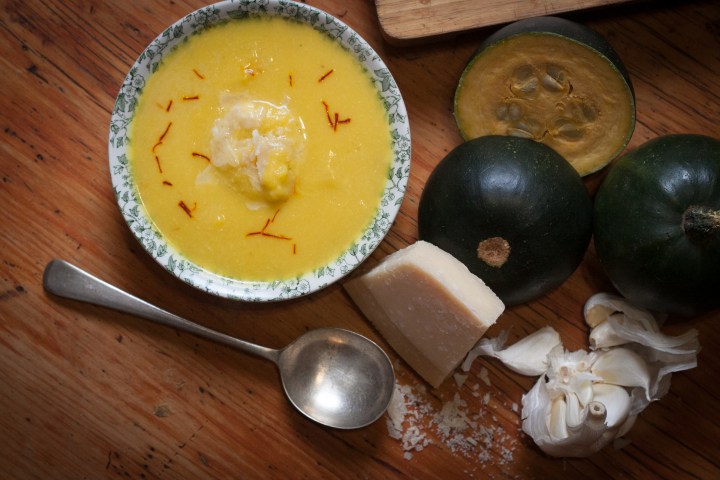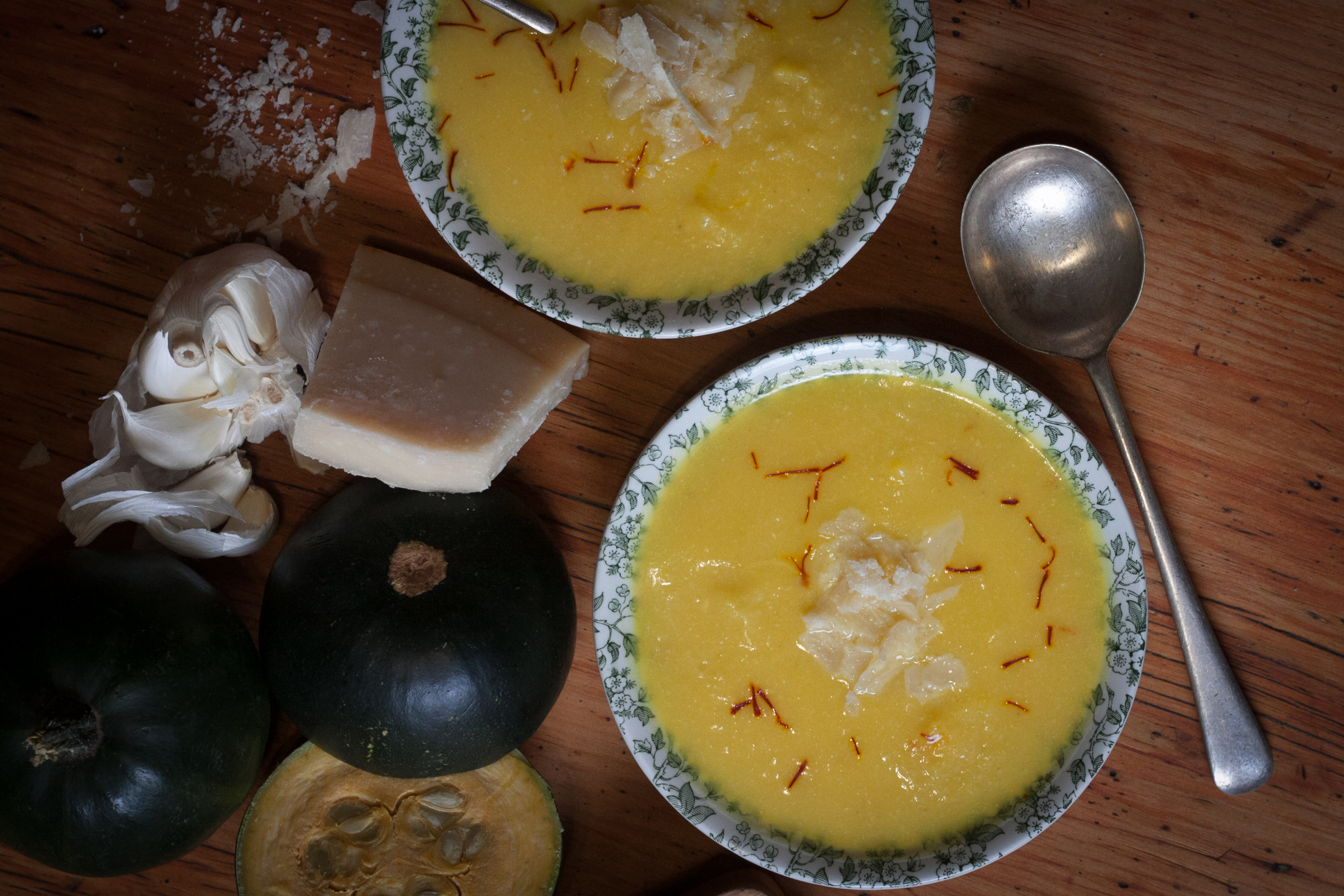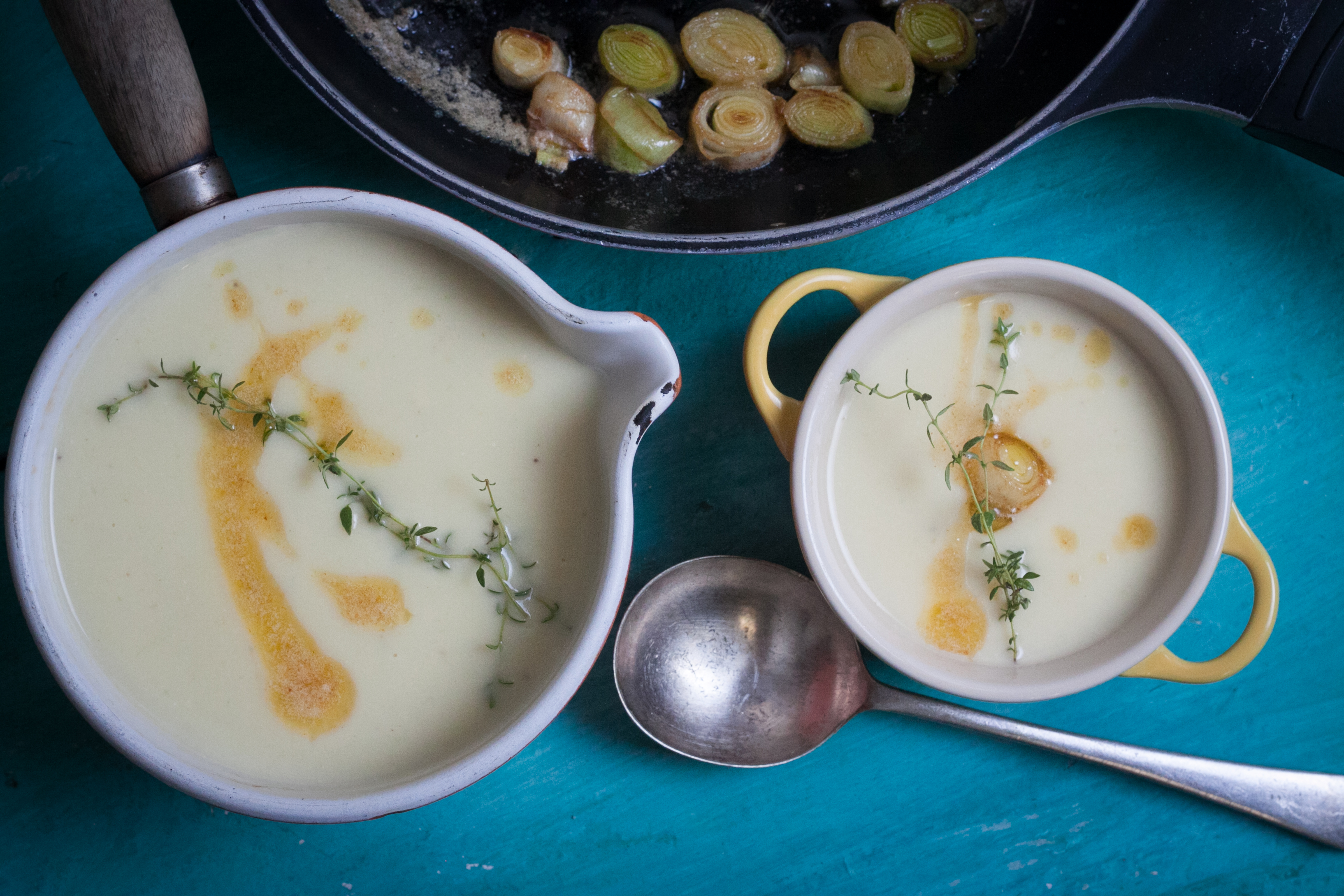GASTROTURF
Soups & Simplicity: Tending broths, sharing lives

The soup in the pot on the fire in the night. The broth is to the palate what the flickering flame is to the naked eye. It soothes and entrances you; it conspires to inflame the senses, fire your memories; it ignites the poet, gets the stories rolling off the tongue, satiates the soul. You sup; you breathe. You live.
Soup-making is an ancient art, and over time we have simplified the craft. Archaeologists who unearth pots from forgotten civilisations and send them off for forensic investigation will tell us that the residues of vegetables, roots and spices can still be identified, evidence of families and friends from distant times gathering around the pot on the outdoor flame, reaching in and savouring the life-affirming wonder of the richly-flavoured broth.
The converse? Slim packets on a shelf. Brands with photos of steaming broths; tomato, mushroom, onion, chicken, beef – if that’s what you think of when you think “soup”, you’re as far away from the real thing as cheap brandy is from Cognac or faux-brand whisky is from Single Malt. The soup in a can is hardly any better. As for instant soups, the ones that only need boiling water stirred into the powder in the mug, let’s not be too precious about it – most of us have been there, on a dire budget, and you can feed a family for next to nothing with a few packets of instant soup and a cheap loaf of government bread.
But. Even a soup made from scratch, using real vegetables or, for that matter, meat, can be done on a tight budget, if you add a hunk of the cheapest bone-in pork or the end-of-fridge beef cuts you can find to the pea or bean soup. If that beef is fatty, even better. Soup loves fat, and is best enriched with a knob of butter just before serving.
Who owns a soup tureen any more, or a potage? Even though the French do use the word potage for soup (sorry, soupe), it is really the name of the pot in which a soup/e is cooked. In fact, the “soupe”, Larousse informs us, was originally “the slice of bread on which was poured the contents of the cooking pot (the potage)”. And potage is “also used to designate unstrained vegetable, meat or fish soups garnished with bread, pasta or rice; it is also used for regional or classic soups with bread added to them, such as French onion soup (Soupe à l’Oignon Gratinée)”.
I read, just this week, a recipe for that dish, which called for onions to be boiled, chopped, water added, boiled, slopped into a dish and a round of toasted baguette lobbed on top. Noooooooooooooo! Quelle horreur! If that’s how you want to make it, the supermarket shelf is calling you.
At the very least, slow-simmer sliced onions in lots of melted butter. But for a great French onion soup you need a low oven, lots of time, and patience. I start it late morning, for supper. You need to slow-roast the onions for hours to attain rich caramelisation. I throw in garlic cloves too, traditional or not. By the time you grate some Gruyère on to rounds of toasted baguette, place them in bowls and pour soup over, the entire house is filled with the delightful aromas of what you’re about to eat, the palate is tripping as if on acid, the taste buds entering a trance-like state.
For the French, soups are five distinct arts – the bouillon and consommé, clear soups, the latter clarified with egg white; purée of vegetable soups thickened by the veggie starch; cream soups that need a roux or béchamel for thickening, and enriched with cream; the velouté (or blond) preparation made with white (ie veal) stock rather than milk as in the case of béchamel; and the bisque, made with shellfish (the shells being removed unless garnishing with, say, a prawn or small crayfish tail), and finished with cream. This is not to say there are not other ways of making a brilliant soup, but in this lexicon alone there is a world of possibilities, from celeriac, asparagus or lobster velouté to solferino to Stracciatella (Italian egg drop soup).
Having said all that, the great man Auguste Escoffier divides soups into two simple camps, thick and clear. In Ma Cuisine, he waxes misty-eyed on the qualities of the simple pot-au-feu, “a very French dish which, in spite of its simplicity, provides a complete meal for the soldiers and the working classes” and which is “the basis of the bourgeois croûte-au-pot and of most of the meat soups … today we see it taking place of honour on the most opulent tables under the guise of ‘Petite marmite’.” (Petite marmite: “the same as a pot-au-feu to which is added a young chicken”. As one does.)
In old France, at the bottom of a potage, on the wooden table in the country kitchen, you’d put a slice of bread. Or, in the bottom of a tureen in the Oregon-floored kombuis of the old Cape Dutch homestead at the old Cape, you’d beat fresh egg yolks with a glass of wine and a grating of mace, and pour it into the bottom of a tureen. In either case, you’d pour the hot soup you’ve just made into the tureen.
The doyen of Cape food writers of the earlier 20th century, C Louis Leopoldt, who incidentally was also a reporter and an early Cape liberal who operated underground during an earlier struggle for liberty and for freedom of the press – he is a key character in my play, Cape of Rebels, about that very era – raised an interesting issue; and bear in mind that he was writing in a very different era from ours. Leipoldt died in 1947, the year before the National Party came to power; which is not to say there was no racial oppression before then. There certainly was. But any thought of decolonisation was unheard of in such times.
In that perhaps now quaint context, then, Leipoldt wrote that the question remained “whether we have a culinary art that can validly be described as genuinely and indigenously Afrikaans”. I’m not convinced he meant only white Afrikaans, because, as as a writer and liberal thinker, he well knew the massive influence on old Cape cooking of the ingredients, dishes and cooking techniques that had come with slaves from the east. The kitchens in which these people – very often employed as cooks in the old houses precisely because of the wonders of their spices and ways with a wooden spoon and a pot – cooked were owned by the Dutch and the French, and later the Afrikaners they were to become, but the cuisines cannot accurately be thought of simply as the product of white colonists. What and wherever the dishes have come from, they belong to all of us now. And we can take up the mantle and find new ways for our future.
As for the suggestion that our kitchens, perhaps, are ripe for the decolonising, let’s not divide ourselves around the table. Food and its eating are there to bring us together, not divide us. (Unless your guest adds salt and pepper to your carefully crafted soup, perhaps. Leipoldt wrote: “I have known a guest’s name deleted from his hostess’s dining list because he had added salt and pepper to his soup, thereby inferentially questioning the cook’s skill.”) He added: “Nowadays we are not so strong minded, and it is not uncommon to see some ‘bright young thing’ lighting a cigarette at table between the soup and the fish course, unwithered by an appositely scathing remark by her hostess.”
That sounds like Leipoldt was writing in the 1920s at the height of the flapper era, by when he would have been well into his middle age and consequently well seasoned in the arts of cooking and dining. It’s a lovely little window into the world in which the great gourmand and poet lived.
Leipoldt, introducing the old Cape soup tradition, observed that “one of the best soups of which mention is made in the older recipes [they were of course old to him too] was undoubtedly developed on the lines laid down by the wandering demobbed soldier in Grimm’s folk-tale. When the first mariners walked on the shores of Table Bay, they found round them almost a meadowland sprinkled with all sorts of edible herbs that to sailormen, yearning for fresh vegetables to counteract the persistent tendency to scurvy that endangered all long voyages, promised immediate relief. It was easy enough to gather armloads of those greens, boil them in the caboose with the addition of scraps of salt pork, consume the resultant liquid as a health-giving soup, and serve up the remaining mess as a vegetable stew”.
Which immediately brings to mind Paternoster chef Kobus van der Merwe, who in his Wolfgat restaurant (reviewed on these pages) uses beach and sea ingredients to create world-impressing dishes.
Leipoldt wrote of limpet soup (“collect as many limpets off the rocks as your backache allows you”) and tortoise soup (an “esteemed and particularly efficacious tonic”), of turtle soup (“at one time dried turtle, and on occasion fresh bits of the creature, were easily procurable at the fish market”) and even of blood soup. (“Take the fresh blood of a fowl and mix it with sifted flour, vinegar, powdered white pepper and salt. Stir this mixture slowly into a boiling chicken stock.”)
We may not go back to all of that. But we can take what we want and leave the rest. Our ingredients and cooking methods came to us from far away, brought by antecedents, but we have our own ingredients and ways too, and we all have one another, which means we have opportunity yet to create, rather than just copy what our forebears may have done.
It’s time for the craft soup, not the packet, and for us to explore the tureen and the beaten eggs and bread that goes in it, and to create craft soups inspired by the recipes of old – and yes, with those influences from France and from the east – but which are as modern, today, as the best of craft beers and single malt whiskies.
There are enough terrible things that divide us. Around our tables in the deep Karoo, we join hands and utter a word of gratitude for the bounty before us, however grand or humble. We can do that wherever we are, whatever our creed or colour, free of dogma but full of bonhomie and the desire to reach out, then dip the ladle deep into the pot, and let the world know that all is good down in the south, where the sun shines and the stars glitter, and where there’s nothing, nothing, that a bit of love and kindness, and a life-affirming bowl of soup, cannot fix. (Recipes for two soups I made this week follow.) DM
Gem Squash and Saffron Soup with Parmesan

Gem Squash and Saffron Soup with Parmesan. Photo: Louis Pieterse
8 plump gem squash
4 Tbs Butter
2 medium onions, finely chopped
2 cloves garlic, smashed
1.2 litres veg stock
100ml cream
Generous pinch of saffron
2 Tbs grated or shaved Parmesan per portion
150g finely grated Parmesan
Salt and pepper to taste
Melt butter in a big, heavy-bottomed pot. Add the onions and garlic and sauté gently on a low heat heat five minutes, stirring now and then.
Peel and chop the gem squash, remove the seeds and add.
Add the vegetable stock. Bring to a boil and then reduce to simmer for 20 to 25 minutes or until the squash is soft.
Cool a little and blend until smooth.
Return to the stove, pour in the cream and add the salt, pepper (go carefully, it must not overpower the saffron) and saffron. Bring to a simmer and cook gently for 10 to 15 minutes, stirring occasionally to ensure it doesn’t catch at the bottom.
Taste and adjust seasoning of you like – that includes the saffron. If too subtle, add a little more and let it simmer to take up the flavour.
Finally, stir in the finely grated Parmesan.
Serve with grated or shavings of Parmesan on top and a deft sprinkling of saffron.
Leek and Potato Soup

Leek and Potato Soup. Photo: Louis Pieterse
4 Tbs butter
1 large onion, finely chopped
6 large or 8 medium leeks
2 sprigs of thyme
I small extra leek for garnish
8 medium potatoes
2 litres vegetable stock
125ml milk
200ml cream
Salt and pepper to taste
Chopped garlic chives to garnish
Melt butter and sauté onion until soft. Add sliced leeks and sauté for 7 or 8 minutes, stirring. Add stock. Salt very well. Peel and quarter potatoes and add. Bring to a boil and reduce to a simmer. Cook until potatoes are soft. Cool a little and blend until smooth. Add milk and cream, season with salt and pepper and bring to a simmer, cooking for 10 to 15 minutes on a gentle heat.
Slice the extra leek and sauté gently in butter with the leaves plucked from the thyme stems, until tender. Garnish the soup with buttered leeks and a few thyme leaves. DM



 Become an Insider
Become an Insider